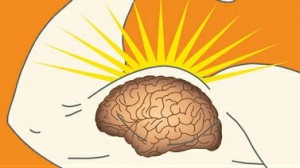
Neuroplasticity, “Use it or lose it”, “Train the brain” ,“Train it to regain it”. These days we hear more and more about retraining the brain.
Fantastic! Exciting! How do you do it? Where do you start?
Before we start if you are interested in a basic introduction to what neuroplasticity is, spend a couple of minutes HERE
Now I want to share two inspiring stories (of the many millions we would find around the world) that help explain why persisting with training the brain can pay off.
There are some tips on how to go about it, AND I hope it fires up your enthusiasm.
This builds on some of the key messages you will hear over and over here – Can Do, “Use it or Lose it”, Build on Strengths, and the importance of lifelong learning for all of us, with or without brain injury.
Last week I talked about learning about brain injury from movies, now I want to show you, that not only can we retrain brains, we can learn about brain injury and strategies from all kinds of places, including from one type of brain injury to another.
Here’s an example. Take the source of that image at the start. I know nothing about baseball pitching. I found “Better Pitching” only because I liked the image. When I looked at the site I found the image was used in an article about training your brain to pitch better at baseball: Better Pitching Part II.
I couldn’t help but notice the talk, and the strategies could easily have been about brain injury; talking about neuroplasticity, training your brain, mental toughness . More on what I learned from Better Pitching below.
First the inspiring stories.
Train the Brain. Neuroplasticity in Action
This first example gives you a brief overview of what neuroplasticity is, and shares an amazing story of a young girl who continues to achieve and live a full life, despite having half of her brain removed to treat a severe form of epilepsy.
Notice the credits at the end that summarise her continuing development, and achievements as she grows up.
The second example is about neuroplasticity and strategies when a person has dementia. Here I am using the experience, and inspiration of Dr Helena Popovic whose father has dementia. You can learn more about Dr Helena Popovic through her website.
If you are supporting a person with a different form of brain injury – don’t switch off; help test out my theory. See if there are lessons to be learned here?
I encourage you to watch the following video of Dr Helena Popovic presenting at the ‘Mind and its Potential ‘conference held in Sydney Australia.
How the Brain Rewires Itself
Encouraging a “Train the brain” approach is increasingly supported by scientific research, demonstrating that other parts of the brain can take up the functions of damaged areas.
For those of you interested in more scientific information the following link is a summary of work carried out by scientists at UCLA and Sydney’s Garvan Institute of Medical Research looking at how the brain rewires itself. [box style=”rounded” border=”full”]The Brain Rewires Itself[/box]
Lessons Learned: Train the Brain after Brain Injury
I learned lessons and got enthusiastic watching Dr Popovic ‘s presentation. Below are just 7 key strategies I picked up.
When reading this list you will hopefully see how strategies in one form of brain injury can often be adapted to other forms.
- Hope is empowering. Hope motivates us. Hope helps us look to the future. Hope can inspire us to give things a go. It keeps us going.
- Take one small step at a time. Helen used a quote attributed to Confucius to beautifully illustrate this :
- “The man who moves a mountain begins by carrying away small stones.”
- ‘Get up after a slip up’ – not everything will work, mistakes will be made but keep going.
- Find ways to challenge; to develop new skills, learn new things, do things in new ways.
- ‘Get an attitude’ – develop a positive attitude yourself and encourage a positive attitude in others.
- ‘Get excited’ – we are all motivated by things we like, things we are passionate about, things that excite us. Find out what this is and build on it.
- Physical, Mental and Emotional stimulation is important: Exercise. Social Connections. Learning.
There was so much more than this in this entertaining and informative video, these were just a few key points that stood out for me.
What else have you picked up from Dr Helena Popovic AND what have you learned from other random sources?
Look for Strategies to Train the Brain in Unusual Places
Maybe a strategy to keep our own brains active could be to try learning more from anywhere and everywhere; starting with brain injury.
As a beginning here are some ideas I picked up from the site I talked about earlier, the one on learning to be a good baseball pitcher:
- Find ways to keep the mind calm and clear when the pressure is on”
- “Treat your brain like a muscle”
- Stay focussed on the “task at hand “
- Meditation and mindfulness training help build mental toughness and focus.
Don’t you think that these strategies (recommended for pitching a ball) could equally be useful (or maybe even more useful!!) for any of us, particularly a person living with brain injury who has cognitive impairment?
Help test out my theory about learning from everything.
In past weeks here we have already learned more about brain injury from handstands, movies, the wonderful Gabrielle Giffords and today baseball pitching.
What have other places and topics have taught you about brain injury?


Pingback: Left Brain Right Brain Function: Same, Same or Different. - Changed Lives, New Journeys
Pingback: Learning From and About: Echolocation and Brain Injury - Changed Lives, New Journeys
Pingback: Willy Wonka, Brain Injury And Brain Myth - Changed Lives New Journeys
Pingback: MEMORY 102: To Store or Not to Store - Short Term Memory to Long Term Memory - Changed Lives New Journeys
Pingback: Planning Successful Strategies for Memory Loss after Brain Injury - Changed Lives New Journeys